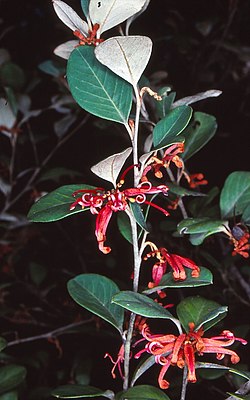Biology:Grevillea oxyantha
| Grevillea oxyantha | |
|---|---|

| |
| Subsp. oxyantha in Deua National Park | |
| Scientific classification | |
| Kingdom: | Plantae |
| Clade: | Tracheophytes |
| Clade: | Angiosperms |
| Clade: | Eudicots |
| Order: | Proteales |
| Family: | Proteaceae |
| Genus: | Grevillea |
| Species: | G. oxyantha
|
| Binomial name | |
| Grevillea oxyantha Makinson[1]
| |
Grevillea oxyantha is a species of flowering plant in the family Proteaceae and is endemic to south-eastern continental Australia. It is an erect to spreading shrub with somewhat silky-hairy branchlets, broadly elliptic to broadly egg-shaped or almost round leaves, and hairy, crimson and pink flowers with a red style.
Description
Grevillea oxyantha is an erect to spreading shrub that typically grows to a height of 1–3 m (3 ft 3 in–9 ft 10 in) and has silky-hairy branchlets. Its leaves are broadly elliptic to broadly egg-shaped or almost round, 20–60 mm (0.79–2.36 in) long and 15–35 mm (0.59–1.38 in) wide, the lower surface covered with woolly or silky hairs. The flowers are arranged in more or less cylindrical clusters on a rachis 8–45 mm (0.31–1.77 in) long. The flowers are scarlet to crimson and woolly- or silky-hairy on the outside, pink inside, the pistil 18–24 mm (0.71–0.94 in) long. Flowering mainly occurs from August to December and the fruit is a glabrous, oval to elliptic follicle 15–20 mm (0.59–0.79 in) long.[2][3][4][5]
Taxonomy
Grevillea oxyantha was first formally described in 1997 by Robert Owen Makinson in the journal Telopea from specimens collected by R.D. Hoogland near Mount Franklin in 1961.[5][6] The specific epithet (oxyantha) means "sharp-flowered", referring to the shape of part of the flower bud.[5]
In the same edition of the journal Telopea, Makinson described two subspecies of G. oxyantha and the names are accepted by the Australian Plant Census:
- Grevillea oxyantha subsp. ecarinata Makinson[7] has egg-shaped to elliptic leaves, the lower surface with straight, silky hairs.[8][9]
- Grevillea oxyantha Makinson subsp. oxyantha[10] has broadly egg-shaped to elliptic or more or less round leaves, the lower surface with woolly, curved to wavy hairs.[11][12]
Distribution and habitat
This grevillea usually grows in rocky places in forest, often near peaks or cliffs, and is found from near Wee Jasper to near Tumut, Batlow and Brown Mountain. Subspecies oxyantha is mostly found in the Brindabella, Tinderry and Kybean Ranges, and south to Brown Mountain in south-eastern New South Wales and the Australian Capital Territory. There are also records from Taradale in central Victoria. Subspecies ecarinata occurs from near Wee Jasper to Tumut and Batlow.[8][9][11][12]
References
- ↑ "Grevillea oxyantha". Australian Plant Census. https://biodiversity.org.au/nsl/services/apc-format/display/161036.
- ↑ Makinson, Robert O.. "Grevillea oxyantha". Royal Botanic Garden Sydney. https://plantnet.rbgsyd.nsw.gov.au/cgi-bin/NSWfl.pl?page=nswfl&lvl=sp&name=Grevillea~oxyantha.
- ↑ "Grevillea oxyantha". Australian Biological Resources Study, Department of Agriculture, Water and the Environment: Canberra. https://profiles.ala.org.au/opus/foa/profile/Grevillea%20oxyantha.
- ↑ Stajsic, Val. "Grevillea oxyantha subsp. oxyantha". Royal Botanic Gardens Victoria. https://vicflora.rbg.vic.gov.au/flora/taxon/36ff2b0c-ea3c-4418-bcd7-5358b0d0ae24.
- ↑ 5.0 5.1 5.2 Makinson, Robert O. (1997). "New segregate species and subspecies from the Grevillea victoriae (Proteaceae: Grevilleoideae) aggregate from south-east New South Wales.". Telopea 7 (2): 130–134. https://www.biodiversitylibrary.org/item/264629#page/38/mode/1up. Retrieved 5 August 2022.
- ↑ "Grevillea oxyantha". APNI. https://id.biodiversity.org.au/instance/apni/559716.
- ↑ "Grevillea oxyantha subsp. ecarinata". Australian Plant Census. https://biodiversity.org.au/nsl/services/apc-format/display/161036.
- ↑ 8.0 8.1 Makinson, Robert O.. "Grevillea oxyantha subsp. ecarinata". Royal Botanic Garden Sydney. https://plantnet.rbgsyd.nsw.gov.au/cgi-bin/NSWfl.pl?page=nswfl&lvl=in&name=Grevillea~oxyantha~subsp.+ecarinata.
- ↑ 9.0 9.1 "Grevillea oxyantha subsp. ecarinata". Australian Biological Resources Study, Department of Agriculture, Water and the Environment: Canberra. https://profiles.ala.org.au/opus/foa/profile/Grevillea%20oxyantha%20subsp.%20ecarinata.
- ↑ "Grevillea oxyantha subsp. oxyantha". Australian Plant Census. https://biodiversity.org.au/nsl/services/apc-format/display/146319.
- ↑ 11.0 11.1 Makinson, Robert O.. "Grevillea oxyantha subsp. oxyantha". Royal Botanic Garden Sydney. https://plantnet.rbgsyd.nsw.gov.au/cgi-bin/NSWfl.pl?page=nswfl&lvl=in&name=Grevillea~oxyantha~subsp.+oxyantha.
- ↑ 12.0 12.1 "Grevillea oxyantha subsp. oxyantha". Australian Biological Resources Study, Department of Agriculture, Water and the Environment: Canberra. https://profiles.ala.org.au/opus/foa/profile/Grevillea%20oxyantha%20subsp.%20oxyantha.
Wikidata ☰ {{{from}}} entry
 |

